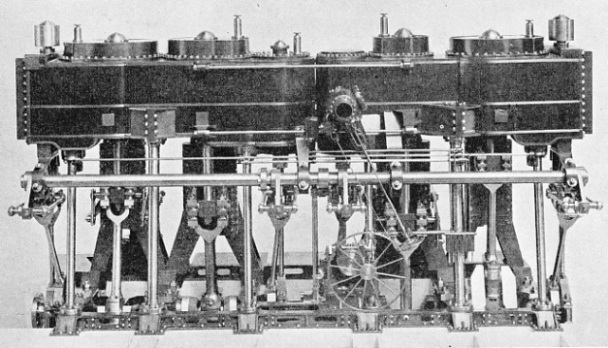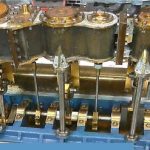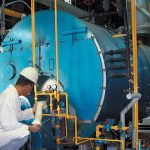In many cases in the mercantile marine the stage expansion principle is carried still further, and quadruple expansion engines fitted, dividing the expansion into four stages, the boiler pressures being generally 200 lbs. per square inch, and in some cases 250 lbs. per square inch.
These engines are more suitable for the mercantile marine, where the range of powers required from the engines is limited, than for the Navy, where this range is large; also as regards the Navy generally, evidence does not show that the additional complication thus introduced, and the extra length of engine room required, together with the additional engine friction, is compensated for by a sufficient gain in economy. They are gradually being introduced into the mercantile marine, but in the Navy only one torpedo boat and some smaller craft have been so fitted.
Improvements in economy.
In consequence of the improvements effected, the consumption of coal with the most recent engines is less than one-third that required for the engines generally used before 1860, and the effect on warships of this great reduction of coal expenditure has been twofold :
a. The increased distance ships are able to steam without exhausting their coal supply has rendered seagoing mast less armour-clad ships possible.
b. The reduced quantity of coal necessary to be carried for the same radius of action has enabled space and weight which would formerly have been required for coals to be devoted to other objects in order to increase their offensive or defensive powers.
Corresponding benefits have also been derived by the mercantile marine.
Forced draught.
The conditions of service of ships in the Royal Navy render it necessary to provide for the development of high power and speed on special occasions, such as the events of action, chasing, etc., although the greater portion of the work of the ship has to be performed at comparatively low powers. It is therefore desirable in warships to provide special means of forcing the boilers when the full speed is required. Formerly a steam jet in the chimney was used for this purpose, but this wastes a lot of fresh water. In 1882 the system of forming the stokeholds into closed compartments, and keeping them under air-pressure by means of blowing fans was adopted and continued to the present day, with results that are satisfactory, provided only a moderate pressure of air be used, and by this means the steam generating powers of the boilers have been largely increased.
Details of the fittings required for this purpose are given in Chapter V. The introduction of forced draught has enabled the weight of machinery to be considerably reduced, and the average weight of machinery for the latest modern warships fitted with circular boilers is about 1 3/4 cwt. per I.H.P. developed with moderate forced draught. A lesser weight than this, viz., 1 1/2 cwt., was at one period allowed, but this is not now recommended. (by comparison, for the side-lever engine, the figure was 13.75 cwts. per I.H.P.)
From this brief sketch a general idea may be formed of the progress that has been made in marine engineering. The machinery of the ‘Salamander,’ built in 1832, weighed 275 tons, developed 400 I.H.P., and consumed 7 to 8 lbs. of coal per horse power.
In modern warships, machinery of the same weight would, under moderate forced draught, be capable of developing satisfactorily at least 3,000 I.H.P., with about one-fourth the consumption of coal per horse-power, and the space occupied would be considerably less. Another important feature is the great increase in the total power now available for the propulsion of vessels at high speeds.
For example, in H.M.S. ‘Terrlble,’ which in 1845 represented the finest type of steam warship of the day, the I.H.P. was less than 2,000, and her speed about 10 knots, while in the present H.M.S. ‘Terrlble,’ a first-class cruiser, the horse-power is 25,600, and the speed 22.8 knots.
In a later series of cruisers, the ‘Drake’ class, the power is still greater, viz. 30,000 I.H.P.



Comments are closed